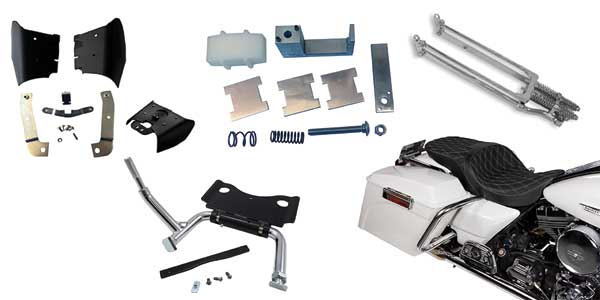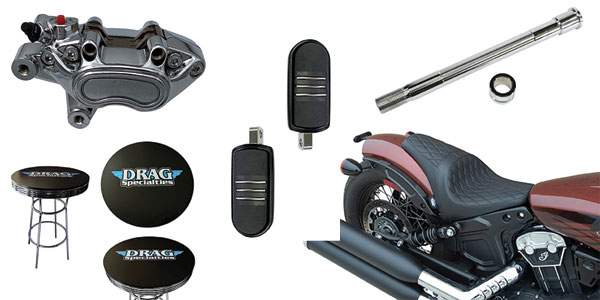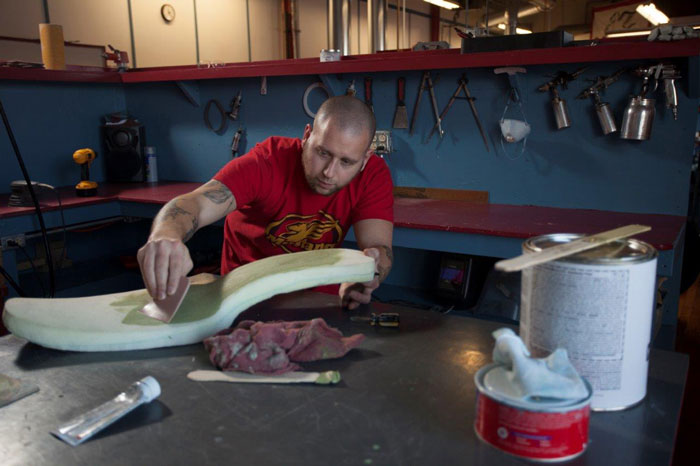
[dropcap]T[/dropcap]hink about why your customers own a motorcycle. Most people ride because it’s fun, right?
However, when it hurts to ride, it’s not fun anymore. When the passenger is asking to stop every 20 minutes or the riders just can’t bear the thought of getting back on the bike after a break, it’s far from fun. And why aren’t they having fun? Their seats aren’t comfortable.
It wasn’t too long ago that motorcycle seats were more or less an afterthought on motorcycles. Riding around on a slab of plastic, metal or hard leather was the only option you had. Today, that is the farthest thing from the truth. Motorcycle seats are now a big aspect of the bike and are built for rider comfort. Riders have a lot of options to find a seat that better fits them and their application.
So what’s been new in motorcycle seats as of late? We spoke with Mustang Motorcycle Products and Roland Sands Design to find out. Most stock seats and a number of less expensive aftermarket seats are built on plastic injection-molded baseplates, which are cheap to build but are far less sturdy than other materials.
“One of the best ways to assess the quality of a motorcycle seat is to turn it over and examine the baseplate area or ‘underbelly,’” says Marilyn Simmons, director of Global Business Development for Mustang Motorcycle Products, LLC. “When you pick up a premium seat, feel the weight and balance. That alone should show you how substantial a custom seat is compared to most stock seats.”
The most important component of seat comfort is the foam – and that includes both the shape and the quality of the foam itself. This is truly a case of what’s inside counts.
“The structure of foam is comprised of both open-cell and closed-cell,” Simmons says. “Think of the difference between types of foam, sponges or cushions on couches. Some foam is really soft and can be easily squeezed and almost flattened (open cell construction) while other foam is really firm and can barely be compressed (closed cell).”
For a motorcycle seat to be comfortable, the foam compound must be carefully formulated to be soft enough for comfort but resilient enough to stand up to 1,000-mile rides. A really soft foam provides no support and is just as bad as riding on the bare baseplate. On the other hand, a really hard foam can make you feel like you’re sitting on a piece of plywood. Either way, your bottom will be in agony at the end of a day’s ride.
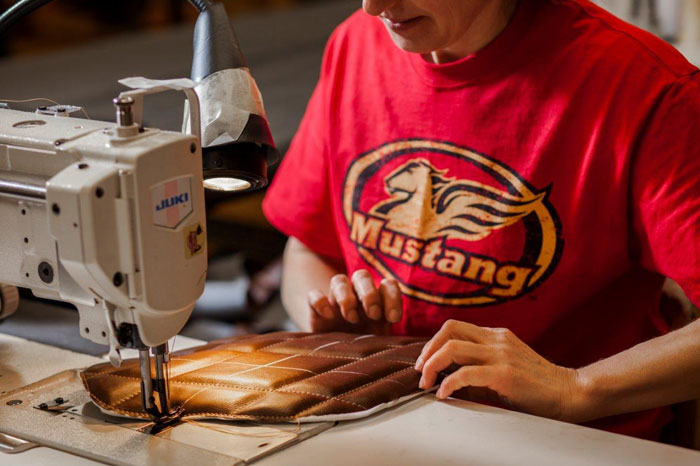 “First-rate foam usually feels firmer than stock, but it shouldn’t feel hard. It should offer ‘gentle’ support,” she says. “A good test is to stand next to the seat and press down on the foam. It should depress by about a third. Most important, there should be no extended ‘break-in’ period before you are comfortable. A new motorcycle seat should adapt to your body shape within the first 15 minutes. The first ride should be as comfortable as the 100th, and the foam should retain its shape and support for years.”
“First-rate foam usually feels firmer than stock, but it shouldn’t feel hard. It should offer ‘gentle’ support,” she says. “A good test is to stand next to the seat and press down on the foam. It should depress by about a third. Most important, there should be no extended ‘break-in’ period before you are comfortable. A new motorcycle seat should adapt to your body shape within the first 15 minutes. The first ride should be as comfortable as the 100th, and the foam should retain its shape and support for years.”
Many riders ask about the use of gel in place of or in addition to foam. Gel displaces – it does not compress like foam. This doesn’t do much for comfort. Foam compresses to support your weight more evenly. Simmons says gel may be the answer for high-pressure, thin applications in a limited area such a bicycle seat or the soles of shoes.
Covers are also an important aspect of the seat, as it’s the portion everyone sees. Most stock seats are covered with molded vinyl that often fails to perfectly fit to the contours of the foam mold or cushion. Discrepancies will result in wrinkles or bulges, and stock covers often lift up from the foam as well.
“Well-designed covers on aftermarket seats must be meticulously pieced together and individually hand-sewn to fit tight contours for a true custom-looking seat,” Simmons says.
The most popular seat cover materials are leather or vinyl – but there is a wide range of quality within each of these categories. Riders should choose the material that best meets their needs, preferences and budget.
“Before insisting on leather, the customer should consider the type of riding they will be doing, where the bike will be stored, how long they want the seat to last and how much time will be devoted to conditioning and maintaining the leather cover,” she says.
Unlike leather, top-grade vinyl will not fade, dry out or crack, nor do you need to worry about it getting wet. Maintenance is not an issue with a premium vinyl either.
“Key features to a good motorcycle seat depend on what the rider is personally looking to accomplish,” says Cameron Brewer, project manager for Roland Sands Design. “A good seat to us blurs the line between style and comfort. We work to create seat designs that follow the natural lines of each particular motorcycle, slim down the overall height and move the ‘pocket’ where it feels best, all while making sure to keep it as comfortable as possible. Quality is also a big deal. Materials that last when exposed to the elements, foam that holds up and doesn’t retain moisture, clean straight stitching and sharp lines.”
Over the past few years, there have been more improvements in design than changes to the seat making process or materials used. Of course, there have been advancements in manufacturing for greater efficiencies, but seats have been changing due to trends.
“The most recent trend would probably be shapes, foam densities and cover materials being changed for performance,” Brewer says. “Lots of people have been taking bikes designed for one thing and using them for something different than they were intended for. Along with other components that make this possible, seats seem to be following along as well.”
This falls under the category of customizing, which has been big in this industry lately, and seats are no exception.
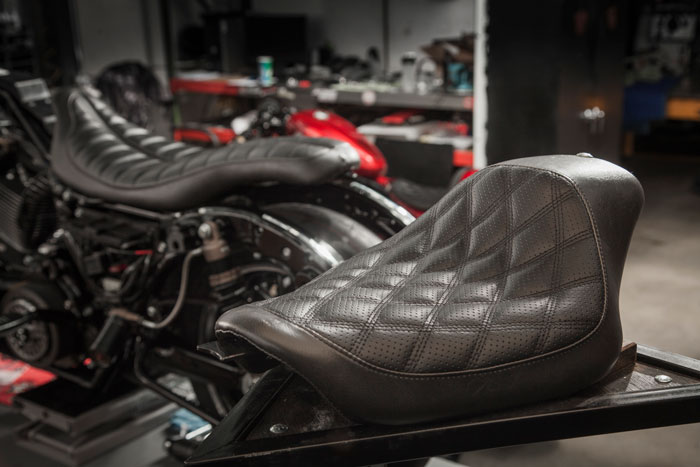 “Many riders are willing to pay more to have their seat look distinctive,” Simmons says. “There are a number of ways customers can achieve this.”
“Many riders are willing to pay more to have their seat look distinctive,” Simmons says. “There are a number of ways customers can achieve this.”
Newer technologies in motorcycle seats also focus on riders’ backs as much as their bottoms.
“Whether sitting in your living room or on your motorcycle, your back deserves the best support,” Simmons says. “Nothing takes the fatigue out of riding more than having full back support and being able to effortlessly adjust your lumbar support frequently. Touring-style seats with driver backrests are the gold standard for all-day riding comfort. They should pivot to match the angle of your back and easily adjust forward and backward, with several height adjustment positions.”
Since seats can be as varied as the bike itself, dealers need to assist customers in selecting the type of seat they need depending on the type of riding to be done or the style or look the buyer wants to achieve.
[pullquote]“The bottom line – dealers need to take the time to explore what seats are available for the particular motorcycle make, model and year and then discuss with their customer what seat is the best choice for them given the style, materials, features and level of comfort they are looking for,” Simmons says.[/pullquote]
Riders need to know they should upgrade their seats for better comfort and to enjoy the ride much more.
“The things that connect the rider to the bike are the most important,” Brewer says. “The things that enhance the ergonomics or comfort of your bike are key. Even if a bike is slow or ugly, if it’s comfortable you really wouldn’t mind riding it all day. Seats are a main part to this formula and if it looks good at the same time, the rider is going to be extra happy. Any part that connects you to the machine is really the most important place to start.”
No other purchase has the long-term impact of enhancing your store’s “bottom line” than a comfortable seat.










